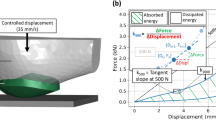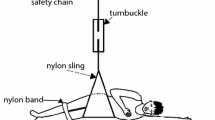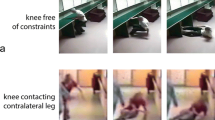Abstract
Hip fracture is a common, costly, and debilitating injury occurring primarily in the elderly. Commonly viewed as a consequence of osteoporosis, it is less often appreciated that >90% of hip fractures are caused by falls, and that fracture risk is governed not only by bone fragility, but also by the mechanics of the fall. Our goal is to develop experimental and mathematical models that describe the dynamics of impact to the hip during a fall, and explain the factors that influence hip contact force and fracture risk during a fall. In the current study, we used “pelvis release experiments” to test the hypothesis that, during a fall on the hip, two pathways exist for energy absorption and force generation at contact: a compressive load path directly in line with the hip, and a flexural load path due to deformation of muscles and ligaments peripheral to the hip. We also explored whether trunk position or muscle contraction influence the body's impact response and the magnitude of force applied to the hip during a fall. Our results suggest that only 15% of total impact force is distributed to structures peripheral to the hip and that peak forces directly applied to the hip are well within the fracture range of the elderly femur. We also found that impacting with the trunk upright significantly increases peak force applied to the hip, whereas muscle contraction has little effect. These results should have application in the development of fracture risk indices that incorporate both fall severity and bone fragility, and the design of interventions such as hip pads and energy-absorbing floors that attempt to reduce fracture risk by decreasing in-line stiffness and hip contact force during a fall.
Similar content being viewed by others
References
Casalena, J.A., A. Badre-Alam, T.C. Ovaert, P.R. Cavanagh, and D.A. Streit. A dual stiffness floor for the reduction of fall injuries: finite element analysis and design. In: Proceedings of the 4th Annual CDC Injury Prevention through Biomechanics Symposium edited by S. J. Shieh. Detroit: Wayne State University, 1994, pp. 21–25.
Courtney, A. C., E.F. Wachtel, B.R. Myers, and W.C. Hayes. Effects of loading rate on strength of the proximal femur.Calc. Tissue Int. 55:53–8, 1994.
Greenspan, S.L., E.R. Myers, L.A. Maitland, N.M. Resnick, and W.C. Hayes. Fall severity and bone mineral density as risk factors for hip fracture in ambulatory elderly.J.A.M.A. 271:128–133,. 1994.
Grisso, J.A., J.L. Kelsey, B.L. Strom, G.Y. Chiu,et al., Risk factors for falls as a cause of hip fracture in women.N. Engl. J. Med. 324:1326–1331, 1991.
Lotz, J.C., and W.C. Hayes. Estimates of hip fracture risk from falls using quantitative computed tomography.J. Bone Joint Surg. [Am.] 72:689–700, 1990.
Melton, L.J., E.Y.S. Chao, and J. Lane. Biomechanical aspects of fractures. In Osteoporosis: etiology, diagnosis, and management, edited by B.L. Riggs and L.J. Melton. New York: Raven Press, 1988, pp. 111–131.
Nevitt, M.C., and S.R. Cummings. Type of fall and risk of hip and wrist fractures: the study of osteoporotic fractures.J. Am. Geriatr. Soc. 41:1226–1234, 1993.
Parkkari, J., P. Kannus, J. Poutala, and I. Vuori. Force attenuation properties of various trochanteric padding materials under typical falling conditions of the elderly.J. Bone Miner. Res. 9:1391–1396, 1994.
Praemer, A., S. Furner, and D. P. Rice, Musculoskeletal Conditions in the United States. Park Ridge, IL, American Academy of Orthopaedic Surgeons, 1992.
Robinovitch, S. N.. Hip fracture and fall impact biomechanics. Cambridge, MA: Harvard/M.I.T., Division of Health, Science, and Technology, Ph.D. Thesis, 1994.
Robinovitch, S. N., W. C. Hayes, and T. A. McMahon. Prediction of femoral impact forces in falls on the hip.J. Biomech. Eng. 113:366–374, 1991.
Robinovitch, S. N., T. A. McMahon, and W. C. Hayes. Force attenuation in trochanteric soft tissues during impact from a fall.J. Orthop. Res. 13:956–962, 1995.
Robinovitch, S. N., T. A. McMahon, and W. C. Hayes. Energy-shunting hip padding system attenuates femoral impact force in a simulated fall.J. Biomech. Eng. 117:409–413, 1995.
van den Kroonenberg, A., W. C. Hayes, and T. A. McMahon. Hip impact velocities and body configurations for experimental falls from standing height.J. Biomech. 29:807–811, 1996.
Author information
Authors and Affiliations
Rights and permissions
About this article
Cite this article
Robinovitch, S.N., Hayes, W.C. & McMahon, T.A. Distribution of contact force during impact to the hip. Ann Biomed Eng 25, 499–508 (1997). https://doi.org/10.1007/BF02684190
Received:
Revised:
Accepted:
Issue Date:
DOI: https://doi.org/10.1007/BF02684190




